Every business has read about the success stories that Google Ads and Microsoft Advertising can offer.
This includes stats that if done right, can earn you $2 for every $1 spent inside Google Ads. While on Microsoft you can lower your CTR 30-50%, increasing your ROAS (Return On Ad Spend) by a phenomenal amount.
These stats are all amazing. But in reality, if you’re staring at a set of campaigns that just aren’t converting, they can seem like a far off dream.
We’re here to help change that. These are the top 3 reasons why your Google and Microsoft ads might not be converting and how you can fix them.
1. You’re not targeting the right audience
Targeting is the centre of successful campaigns. You’re never going to increase clicks or sales if your ads are showing to people who aren’t interested in what you’re saying.
Now there are so many audience targeting options available on Google and Microsoft that it can be easy to get completely overwhelmed by them. So we’ll talk you through some of the options, including when you should be using them and when they should be avoided.
But before we dive into this, you need to think about who you’re targeting in the first place. Having a clear idea about your audience is necessary, so get that crystal clear first. If it helps, you might want to spend some time creating a customer persona.
Right, that’s the disclaimer out the way. Let’s talk about some of your targeting options.

Remarketing
Remarketing is a brilliant way of targeting people who have already interacted with your brand but didn’t buy from you. It’s great because you can create adverts that are super-specific and give your potential customers a second chance to buy.
You don’t have to go through the stages of making customers aware of your brand and building trust. They’re already familiar with you, all you need to do is nudge them over the final line. That’s why it’s always cheaper and easier to try and convert an existing customer than to bring new ones into your funnel.
Remarketing lists are available both on Google and Microsoft. All you need to do is install a pixel on your website (similar to Facebook) and select the type of users that you want to target, such as all site visitors or just cart abandoners.
Google Affinity Audiences
Affinity audiences let you target people based on their known interests and hobbies. So, if a Google user is known to commonly visit websites about fishing, they can be targeted under that assumption.
This type of audience is great for expanding your reach and building brand awareness in front of customers with specific interests.
In-Market Audiences
In-market audiences are similar to affinity audiences but are based on what people are searching right now. It’s not about long term interests here, it’s about people who have recently searched for purchased-based keywords, like “fishing rod for sale”.
They might not be a long-term fishing fan, but they’re in the market right now.
In-market audiences are great to use for campaigns that are closer to the end of the funnel. At the moment, in-market audiences are only available on Microsoft in the US, Canada and Australia.

Customer Match
Similar to remarketing, customer match audiences are customer lists that are made using your own data. For example, you could target people who have signed up to your newsletter, to watch a webinar or have given their email address in an in-store competition
Detailed Demographics
This allows you to target audiences on Google and Microsoft using on long-term facts, such as:
- Age
- Gender
- Location
- Language
- Education
You can also use free tools like Adzooma that help improve this audience targeting further too.
Once you’ve connected your Google or Microsoft account, your campaigns will be monitored on an ongoing basis and in the Opportunities tab you will get a list of actions you can take to improve your ads in just a couple of clicks. These Opportunities will be different for everyone depending on the status of your account, but here’s an example below:
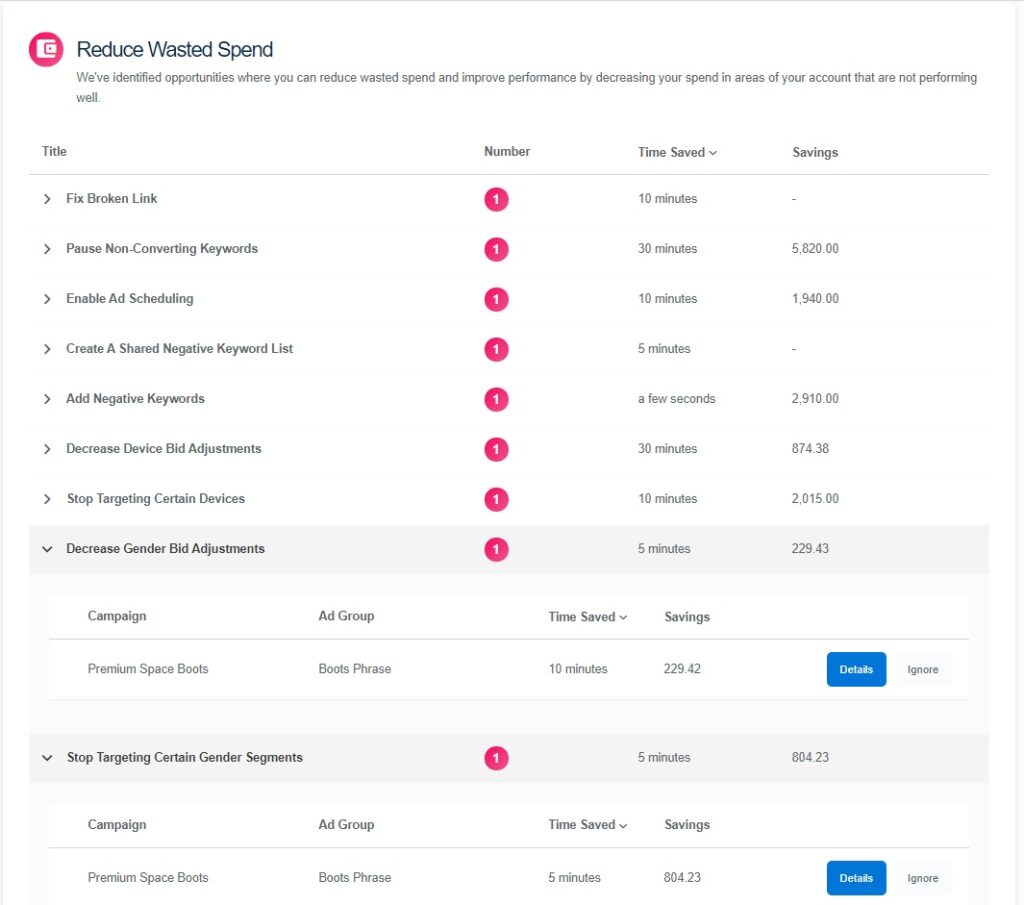
From there, if you click details you’ll see what the recommendation Adzooma is making for you and why, plus the saving you can make by applying this Opportunity. By clicking Add To Queue, you will then apply this change to your campaign.
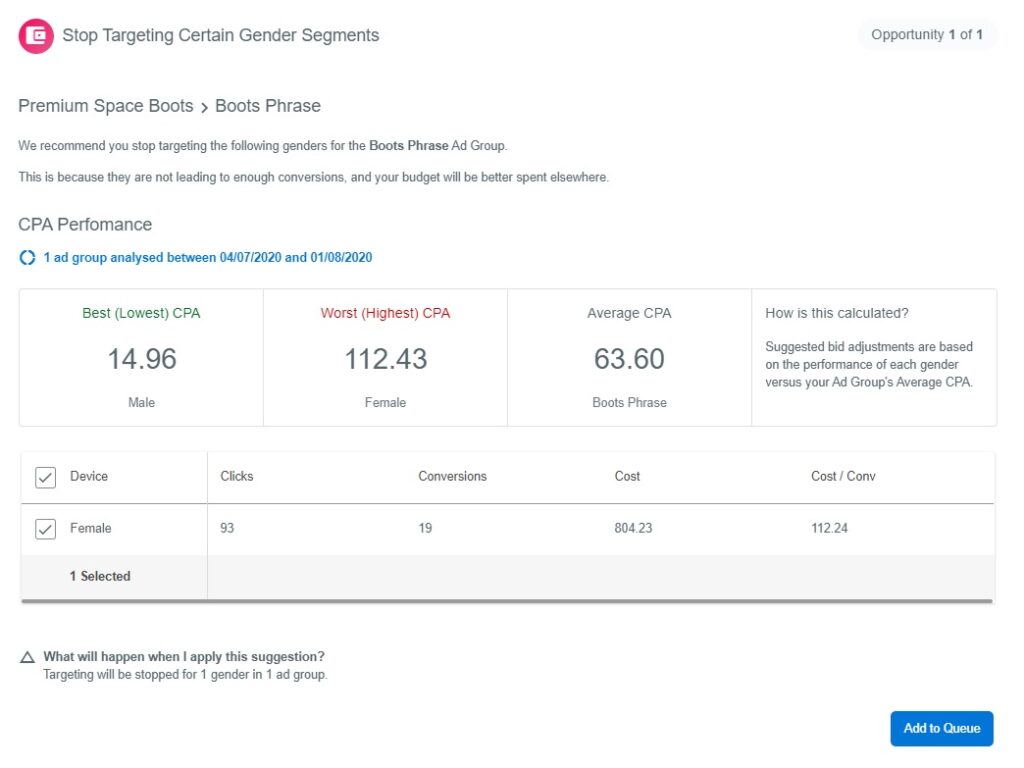
Not signed up to Adzooma yet?
With a full automation suite, 24/7 account monitoring, one-click improvements, intelligent reporting, and so much more, Adzooma is the smarter and easier way to manage your Google, Microsoft and Facebook ads.
Best of all? It’s completely free!
LinkedIn Profile Targeting
Because LinkedIn is a part of the Microsoft group, Microsoft Ads also gives you the option to target people based on their LinkedIn profiles. This can include information such as the company they work for, job title or industry – making it a really useful tool for B2B companies.
On average, the CVR for LinkedIn Profile Targeting campaigns are 42% higher than when the same ads are shown to non-audience targeted users. It’s one of the reasons why Microsoft Advertising is one of the strongest platforms around.
For more on LinkedIn targeting in Microsoft Ads, read our Mythbusters guide on Google Ads and Microsoft Ads.
Not advertising on Microsoft yet? You can get $125 in free ad spend when you spend $25, thanks to our exclusive offer.
Then connect your account to Adzooma and manage both your Google and Microsoft campaigns from one screen.
Similar Audiences
Similar audiences can be used on both Google and Microsoft to advertise to users that are similar to your existing customers. This feature is best for companies who are already achieving a good conversion rate with their advertising – but want to expand out to new users.
2. You’re not using the right keywords
If your campaigns aren’t converting, there’s a big chance you’re not targeting the right keywords.
It’s like trying to build a house on mud. You need to make sure that your foundations are solid before building up. One of the most common mistakes with keywords is not factoring in the intent.
Each time someone searches on Google or Microsoft, they’re doing it for a very specific reason. It’s not for fun, it’s because they need to know or find something asap. Knowing the search intent will help you target your ads to these audiences, giving them the exact info they need.

Generally, there are 4 types of keyword intent.
1. Informational
These are often questions based on the classic who, what, where, when and why when a user needs to know information. They’re best suited for top of the funnel ads and brand awareness.
Example: “How do you build a bathroom extension”
2. Commercial
These are searches that people make when they are researching a product or a service. They’re best used for the middle of the funnel adverts, where users know they’re in the market for a product but don’t know which one to buy.
Example: “The best bathroom fitters in York”
3. Transactional
These tend to be made by people who are ready to buy and usually have more technical or specific language involved. They present the most opportunity for your company to make conversions but will tend to be the most targeted and expensive keywords to bid on.
Example: “Buy chrome thermostatic shower mixer set”
4. Navigational
These searches are used when users want to know where a physical place or a specific web page is.
Example: “Amazon customer support”
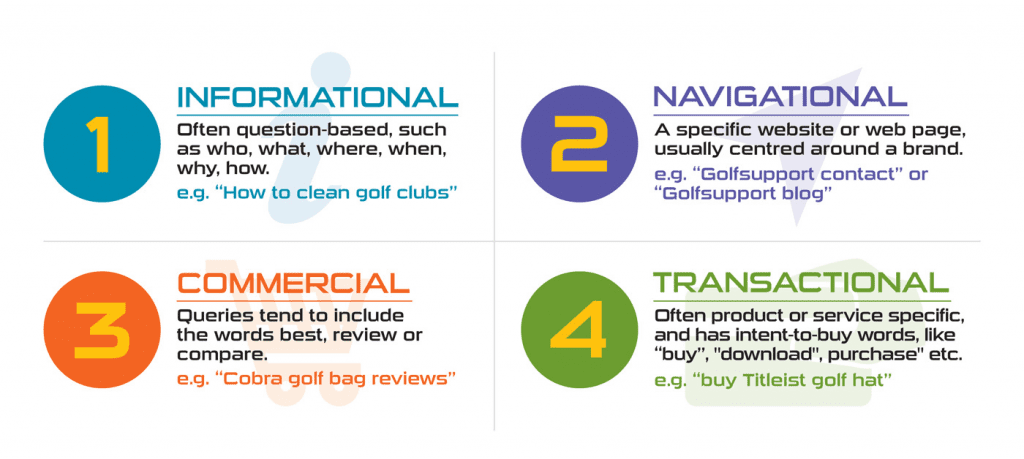
Inspiration
We’ve written a real in depth piece about how to conduct keyword research the smart way, which you should read if you’re struggling for inspiration.
For a quick roundup, we talk about how knowing yourself is so important to attracting the right audience, how important it is to thoroughly research your industry and your competitor’s, and how you should always continue to optimise and refine even if you’re performing well.
Check out SEMRush’s Keyword Magic Tool which generates over 2 million keyword ideas for SEO and PPC campaigns and group them by topic. If you find a handful of interesting keywords, you can save them in the Keyword Analyzer and estimate the number of clicks and how likely you’ll rank for them in the top 10 of the SERPs.
You can also use SEMRush to analyse what keywords your competitors are bidding on. All in all, a great tool that will get your content up the SERPs.
You should utilise the Adzooma platform too to help with this. Again, if you head to the Opportunities tab you’ll see example actions you can take in the Improve Performance section that can help with your keywords like below.
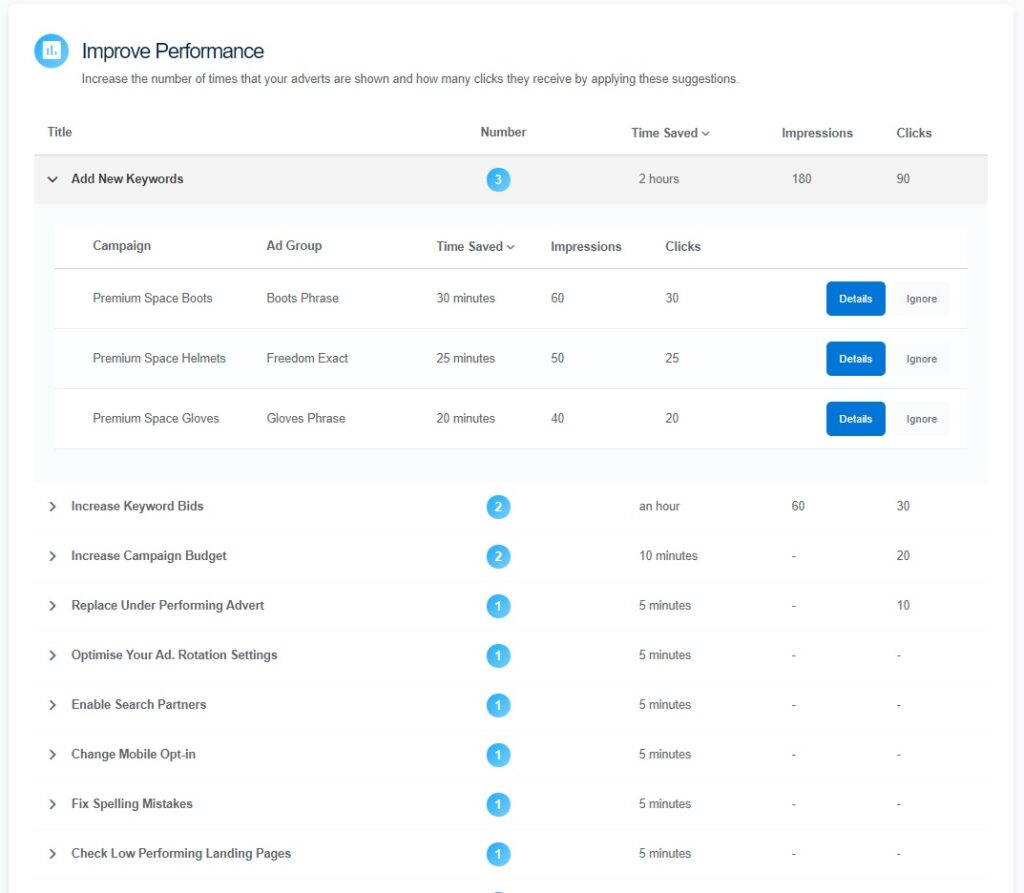
Once you’ve clicked details you’ll see a little bit more info.
These keyword Opportunities are generated based on previous performance data which is analysed by our platform. From that analysis, it provides you an estimated impression and click uplift that you’d receive should you take the actions.
To add them to your campaign, you just need to click Add To Queue which saves you a whole chunk of time and effort in the research stage – approximately 2 hours according to our platform!
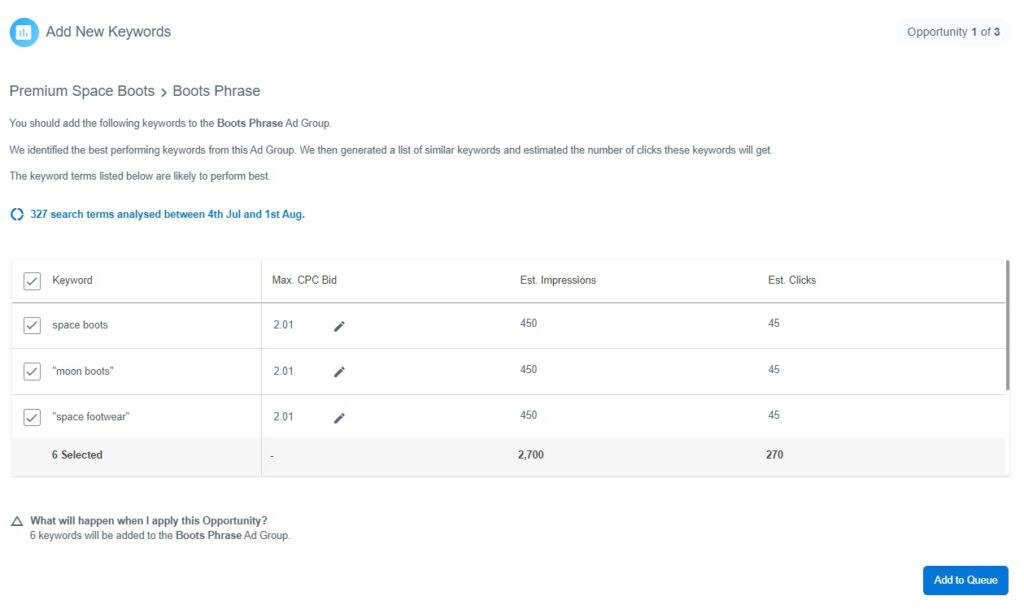
3. Your landing page isn’t optimised for conversions
Conversions happen when all pieces of your marketing come together. If you have a weak link in your customer journey, the whole thing can break.
If you’re getting the clicks but not the conversions, it means that there might be some issues with your landing page.
Your landing page is the page of your website that users go to after they click the ad. To up your conversions, it needs to be relevant to what people clicked and designed in a way that urges them to convert. And improving your landing page experience is part of the way Google Ads calculates your Quality Score and Ad Rank.
Common conversion pain points on your landing page are factors like not giving people enough information, missing testimonials or customer reviews or even site speed. If your website is too slow to load, customers will leave. That’s the harsh reality of how impatient we all are.
We’ve written some great pieces on this you should take a read through to improve your landing pages:
- What Makes A Landing Page Convert – A Cambridge University and Adzooma Study
- 15 Inspiring Landing Pages You’ll Want For Your Site
- How To Improve Your Landing Page Experience
Then once you’ve done your best to optimise your pages, the Adzooma platform will continually monitor things like your landing page experience, landing page load time, and landing page mobile UX to make sure your landing pages are always on form:
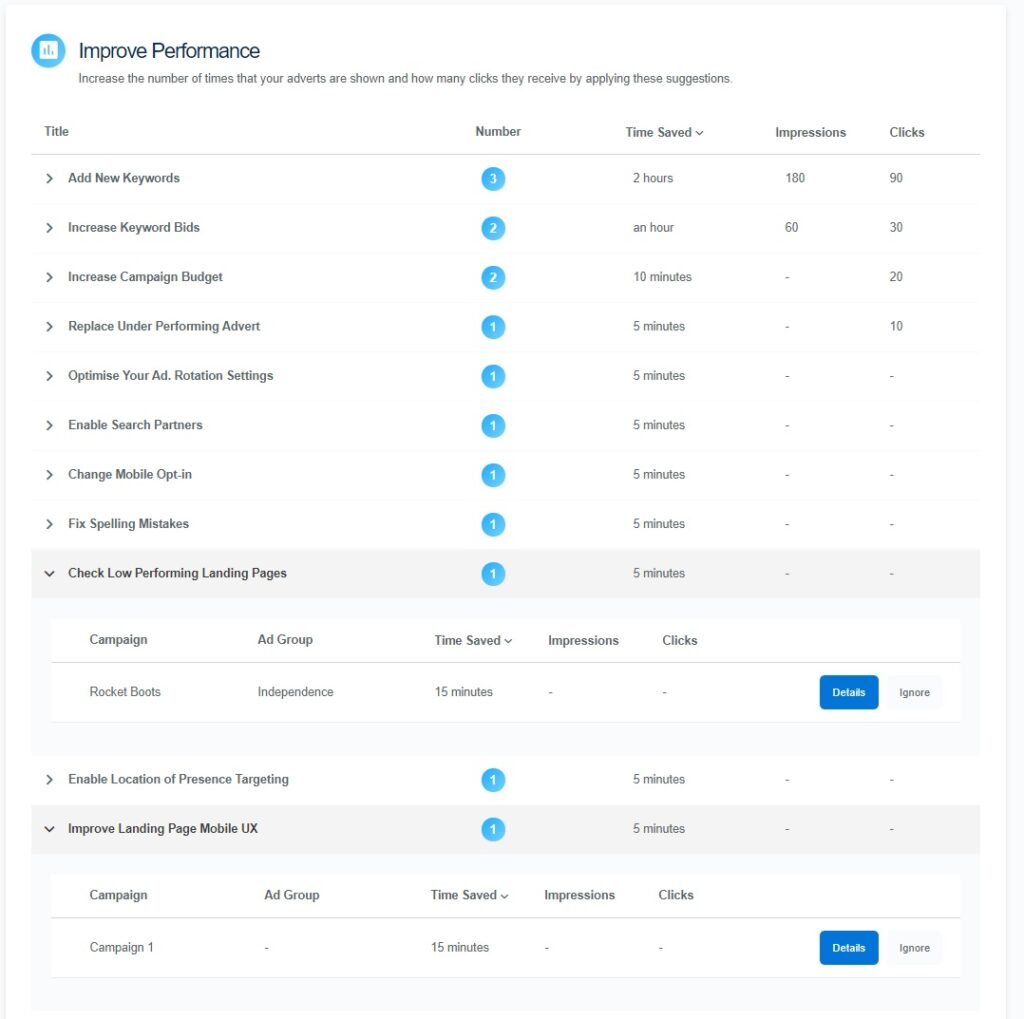
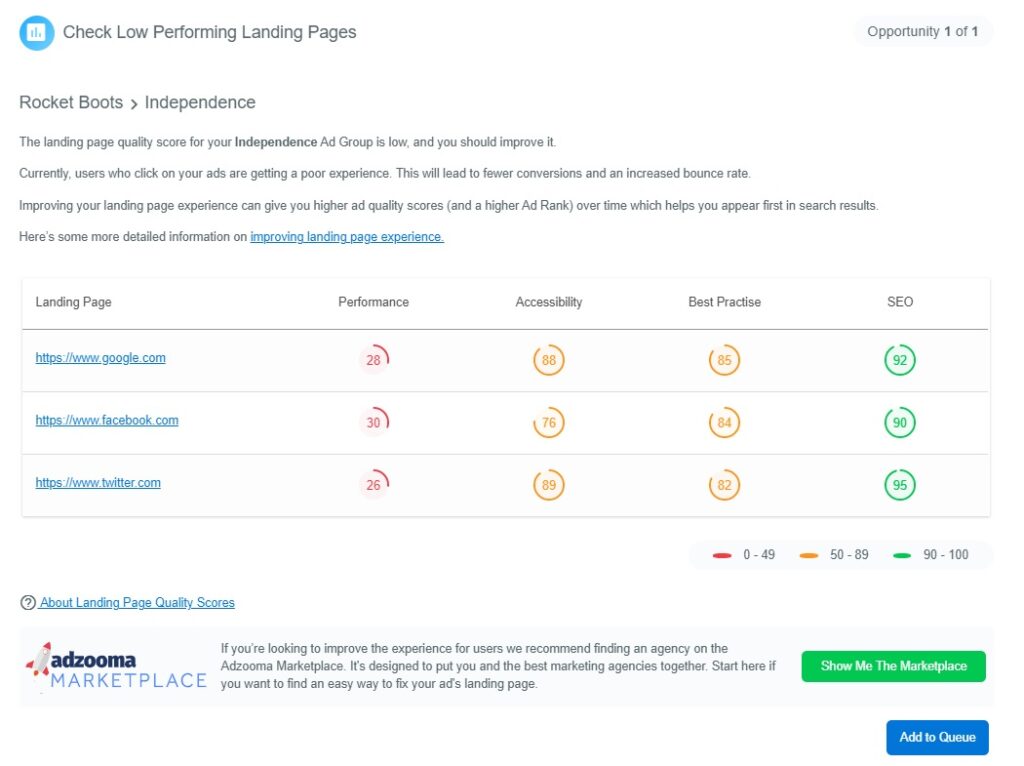
But improving your landing page isn’t always an easy fix, and that’s why we created the Adzooma Marketplace.
Our marketplace is full of agencies and specialists who transform your landing page if you don’t feel confident in doing it yourself. From leading copywriter and designers, to agencies who can take charge of all your PPC campaigns, Adzooma Marketplace is the place to find all the local and leading agencies that are available to help your business right now.
All you have to do is put in what you’re looking for and we’ll give you a list of available agencies ready to contact and help you boost your conversions.
Happy converting!




